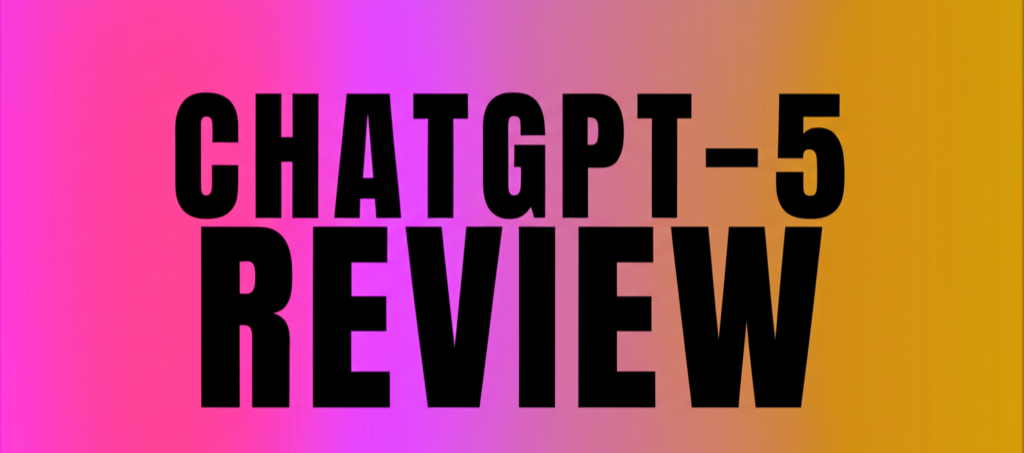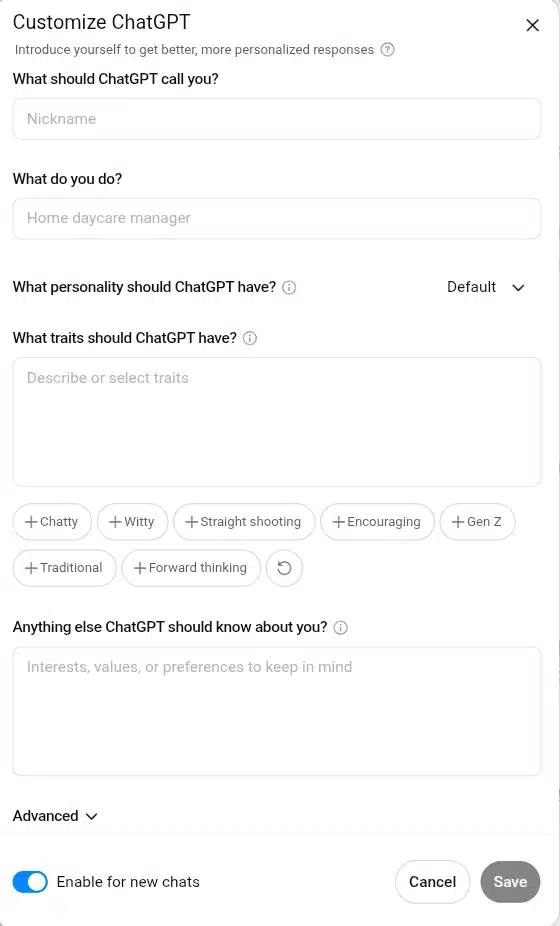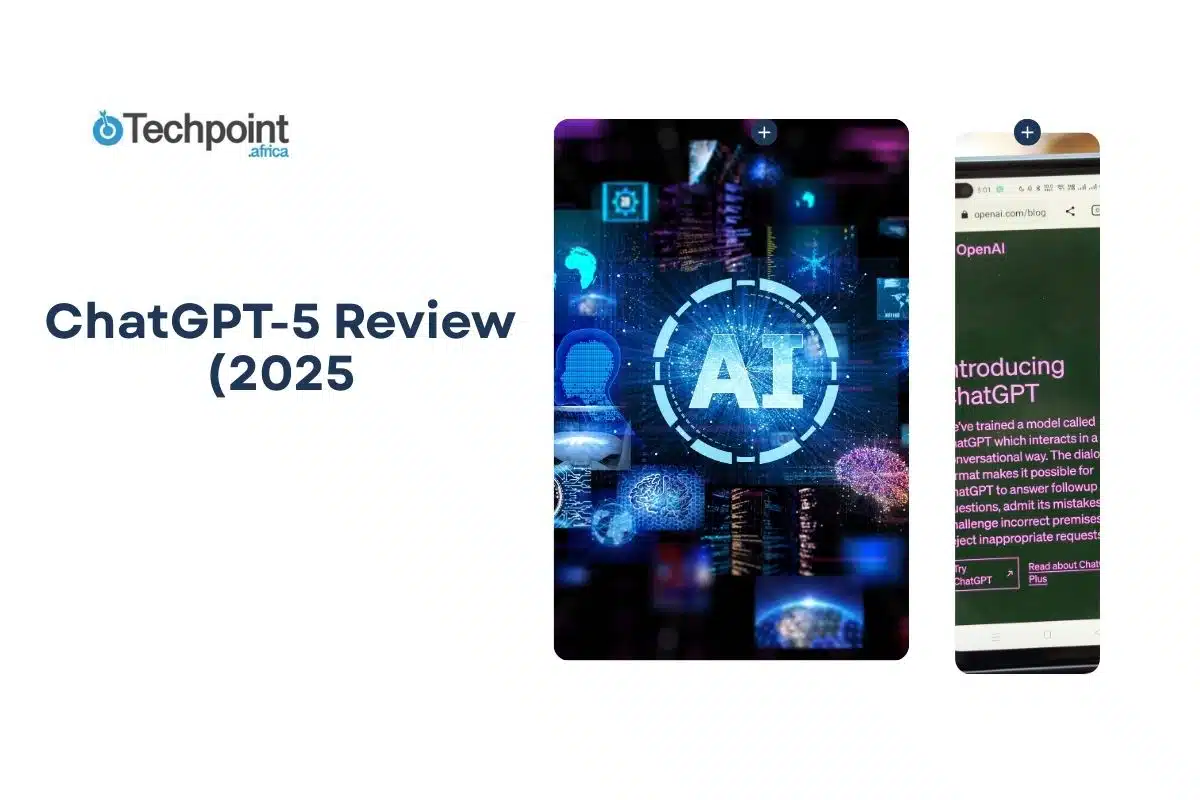
When August 2025 arrived, Taylor Swift fans celebrated the month across social media platforms, sharing lyrics and tributes to her song ‘August.’ However, that wasn’t the only event planned for the month, as OpenAI had its own announcements.
Announcement that led to the packing up of GPT-4 for the unveiling of GPT-5. The upgrade was received with enthusiasm, excitement, speculation, and skepticism, and for good reasons, too. Each significant release changes not only the way the model responds but also how people decide to use it.
I approached ChatGPT-5 with a clean slate, not letting the hype and increasing subjective reviews get to me. I wanted to see how it actually performed in real tasks, on my own terms. After all, a new AI model isn’t just about what it promises but whether it delivers when it matters.
Here’s how ChatGPT-5 performed during my week of freestyle use. First, I’ll discuss the features I found and what they can do for you.
What features are added to ChatGPT-5?
ChatGPT-5 introduces many new features that significantly enhance how you can interact with the AI, making it more versatile, personalized, and practical for daily use. Several additions were particularly impactful over the past week of using the model. Here they are:
Gmail, Google Calendar, and Google Contacts connectors
One of the most immediately noticeable improvements is the integration of Gmail, Google Calendar, and Google Contacts for Plus and Pro users. With these connectors, ChatGPT-5 can reference your emails, calendar events, and contacts directly in conversation. This makes it easier to draft emails, plan schedules, or reference past interactions without manually copying or summarizing information.
The rollout began for Pro users first, followed by Plus accounts, and is gradually extending to Team, Enterprise, and Edu plans. This feature reflects a clear push toward productivity-focused AI interactions, reducing friction in everyday digital tasks.
Expanded connectors for third-party tools
Beyond Google apps, ChatGPT-5 now supports additional connectors. Plus, users can connect with Box, Canva, Dropbox, HubSpot, Notion, Microsoft SharePoint, and Microsoft Teams, while Pro users can also integrate Microsoft Teams and GitHub. These connectors enable ChatGPT to pull relevant data directly from work or project tools. In my experience, having these integrations active allows the AI to respond with contextually aware answers that feel grounded in real-world information rather than generic knowledge. While still in beta, these connectors are already improving workflow efficiency and creative collaboration.
Multiple personalities
ChatGPT-5 introduces four optional personalities in addition to the Default style: Cynic, Robot, Listener, and Nerd. Each personality modifies the tone, style, and approach of responses. I noticed that choosing a personality significantly changes how the AI communicates: the Cynic delivers blunt, witty responses; the Listener feels warm and reflective; the Nerd is playful and explanatory; and the Robot is precise and emotionless. While these personalities do not apply to Voice mode, they offer a layer of customization that can make interactions more enjoyable or better suited to specific tasks.
Accent colors and personalization
Another subtle but visually impactful feature is the ability to set accent colors in ChatGPT. This personalization affects conversation bubbles, the Voice button, and highlighted text, helping users create a more visually comfortable and customized environment. Though cosmetic, this minor adjustment enhances the feeling of control and ownership over the interface. Selecting an accent color on both web and mobile is intuitive, making personalization accessible to all users.
Voice mode updates
Voice Mode in ChatGPT-5 has been enhanced to provide nearly unlimited use for Plus users and expanded access for Free users. The AI now adapts its speaking style (length, speed, and tone) based on instructions. From my testing, these updates make spoken interactions feel more natural and responsive. Standard Voice Mode has been retired, unifying all users onto this latest voice experience, simplifying usage, and improving consistency.
Study mode
Study Mode is available across the devices you’re most likely to use (iOS, Android, web, and desktop), and will soon expand to Edu plans globally. It’s designed to help you develop a deeper understanding of any topic by guiding you through structured, interactive learning.
With Study Mode enabled, you can explore a topic step by step. It breaks concepts into clear, easy-to-follow sections, gradually increasing in complexity so you can build knowledge at your own pace. The feature also personalizes guidance if your memory is turned on, using examples and context from your previous interactions to make responses more relevant.
You can check your understanding through open-ended prompts and immediate feedback. Additionally, Study Mode allows you to work with your own materials, such as PDFs or images, which the model can reference directly in its explanations.
Activating Study Mode is simple: select Tools in the chat window, choose Study, or visit chatgpt.com/studymode. While behavior may occasionally be inconsistent, this feature provides a practical way to engage with material, making complex subjects more straightforward to understand and retain.
Developer enhancements: GPT-5, GPT-5 Mini, and GPT-5 Nano
For developers, GPT-5 introduces high-quality coding capabilities, front-end UI generation, personality, steerability, and reasoning improvements. It now offers “minimal” reasoning and verbosity parameters. Token limits are massive, with 400K context length and 128K max output tokens. Pricing varies by model: GPT-5 costs $1.25 per 1 million input tokens and $10 per 1 million output tokens. GPT-5 Mini costs $ 0.25 per 1 million input tokens and $2 per 1 million output tokens, and GPT-5 Nano costs $0.05 per 1 million input tokens and $ 0.40 per 1 million output tokens. These changes reflect a clear focus on scalability, performance, and cost flexibility to meet the diverse needs of developers.
GPT-5 mode options: Auto, Fast, and Thinking
Finally, users can now choose between “Auto,” “Fast,” and “Thinking” modes. While most users will prefer Auto, the additional control allows fine-tuning of speed versus reasoning depth. ChatGPT Plus users have a weekly message limit for GPT-5 Thinking, after which GPT-5 Thinking Mini continues the session. This offers a balance between high-performance reasoning and efficiency, depending on user priorities.
Full app development capability
ChatGPT-5 can create complete applications from scratch. This includes writing clean, production-ready code in various programming languages, designing user interfaces, integrating APIs, and even offering guidance for deployment. It can generate both frontend and backend logic, making it possible to go from idea to functional software without manually coding everything.
The features in ChatGPT-5 emphasize personalization, productivity, learning, and professional use. Connectors, personalities, voice enhancements, Study Mode, and developer tools all work together to create an AI experience that adapts to your needs, responds to context, and supports a variety of tasks more effectively.
Do you need to pay separately for ChatGPT-5?
No. Access to ChatGPT-5 depends on your subscription plan, but you don’t need to pay separately for the core model beyond the standard monthly fees. The Free Plan provides limited access to GPT-5, while paid tiers (Plus, Pro, and Team) offer expanded usage and additional features.
Plus, it costs $20 per month and gives you access to GPT-5 with increased message limits. The Pro plan is $200 per month, offering more advanced capabilities and the GPT-5 Thinking model for complex tasks. Team and Edu plans range from $25 to $30 per user per month, while Enterprise plans have custom pricing tailored to organizational needs. These plans provide structured access to GPT-5 without additional subscription charges for the standard experience.
Usage limits vary depending on the plan. Free tier users can send up to 10 messages every five hours, with access to one GPT-5 Thinking message per day. After reaching these limits, chats automatically switch to a smaller, mini version of the model until your limit resets. Plus, users can send up to 160 messages every three hours with GPT-5, after which conversations temporarily move to GPT-5 Mini.
Plus and Team users can manually select GPT-5 Thinking, which has a weekly limit of 3,000 messages. A notification will appear when this limit is reached, and GPT-5 Thinking will become unavailable until the following week. Automatic switching between GPT-5 and GPT-5 Thinking does not count toward this weekly limit.
Pro and Team plans offer effectively unlimited GPT-5 access, subject to guardrails that prevent misuse, such as reselling access, sharing accounts, or automated data extraction. Any temporary restrictions are communicated by support, and access is restored if no violations are found.
Context windows also differ by plan and mode. Free users have a 16K token window in Fast mode, Plus and Team users have 32K, and Pro or Enterprise users enjoy 128K. GPT-5 Thinking for all paid tiers supports a 196K token context, allowing the model to handle larger conversations and more complex tasks without losing track of prior information.
For developers or anyone using the API, GPT-5 introduces a token-based pricing model. The standard GPT-5 model costs $1.25 per 1M input tokens, $0.125 per 1M cached input tokens, and $10 per 1M output tokens. GPT-5 Mini is a faster, lower-cost option at $0.25 per 1M input tokens, $0.025 per 1M cached input tokens, and $2 per 1M output tokens. GPT-5 Nano is the most affordable and fastest version, suitable for summarization and classification tasks, priced at $0.05 per 1 million input tokens, $0.005 per 1 million cached input tokens, and $0.40 per 1 million output tokens. These options allow developers to scale usage depending on performance and budget needs.
With these options, you can select a plan and mode that fits your usage pattern, whether you’re sending casual queries, working on complex research, or integrating GPT-5 into an application. ChatGPT-5 offers regular users and developers flexibility, balancing accessibility with high-performance capabilities.
Performances I observed ChatGPT-5 do while using it
I used ChatGPT-5 for one week, testing it across different tasks to see how it fits into my workflow. This included utilizing its deep research feature for an article I was writing, experimenting with its ability to handle varied prompts, and comparing it with the tools I usually rely on. The goal was to understand its strengths and gaps in practical, everyday use rather than in controlled demonstrations.
The bad side
1. Memory retention feels worse than before
This was the first and most surprising disappointment for me. The memory retention in ChatGPT-5 is… well, let’s be blunt: it’s bad. It was so bad that at one point, it completely forgot what it had written for me just a few messages earlier. I was editing a paragraph that it had generated (I asked it to make specific changes), and instead of simply updating it, the system seemed to have no record of the text it had just produced.

The only way to complete the edit was to manually copy the exact text that had been written and paste it back into the chat. Then, I had to re-explain the changes I wanted. In my entire experience with ChatGPT-4, this was never the case. The older model could recall previous text within the conversation without any issues. You could even revisit a conversation from the previous day, and it would pick up right where you left off.
It is baffling that this memory reliability took a step backward in a newer, more “advanced” model. Memory is one of the key things that makes AI feel collaborative, and here, it just didn’t deliver.
2. Occasional glitches while generating
The second thing I noticed is that ChatGPT-5 sometimes fails to respond smoothly. You can send it a prompt, and instead of an immediate answer, nothing happens — or worse, it starts writing and then freezes halfway through.
This isn’t a one-off bug. It happened multiple times. Sometimes, I had to send the same prompt twice before getting a complete, uninterrupted response.

Again, this is not something I recall experiencing with ChatGPT-4, at least not at this frequency. It’s a small thing, but when you’re in the middle of work, these minor interruptions pile up and break your flow.
3. Strict usage limits for free users
Another downside (and one that hits immediately if you’re not on a paid plan) is the strict usage limit. Free tier users can only send a certain number of messages before they hit the cap, at which point they’re either switched to a less powerful model or forced to wait until the limit resets.

It’s not just a little inconvenient. You can be deep into a conversation, mid-project even, and suddenly you’re cut off. In my experience, this almost always happens right when you need it the most. It’s clear that this is designed to push people toward upgrading to a paid plan, but from a user perspective, it feels abrupt.
4. No interface change
Now, this one might seem minor compared to the other points, but I still think it matters. Despite being a significant upgrade in terms of AI capabilities, the interface looks exactly the same.
Why is that a problem? Because if the upgrade isn’t visually obvious, many casual users won’t even realize there’s a new model. I’ve spoken to people who had no idea GPT-5 existed because everything on their screen still looks like it did months ago. Even a minor visual tweak could have signaled that something new and more advanced was available.
The good side
It’s not all bad. In fact, once you move past those frustrations, I think several improvements in GPT-5 are genuinely valuable, and in some cases, game-changing.
1. Cleaner writing style
One thing I noticed almost immediately is the reduced use of unnecessary dashes and overly complex sentence structures. The writing feels cleaner, more direct, and easier to read. Gone are the overly “flowery” AI phrases that used to pop up, especially in GPT-4. This makes a big difference for anyone using it to create professional or straightforward content.
2. More accurate citations in Deep Research
I tested the Deep Research feature specifically to see how well it handled citations and was impressed. The references it provided were actually relevant to the topic, free from broken links, and properly formatted.
In GPT-4, citations sometimes led to irrelevant pages or outright dead links, which made fact-checking a chore. GPT-5, in my testing, consistently gave me sources that actually backed up its claims. This makes it far more reliable for academic, journalistic, or technical work where accuracy is critical.
3. Smarter follow-up questions
This is one of my favorite changes. Instead of mindlessly running with whatever prompt you give it, GPT-5 often asks clarifying questions before it begins.
For example, if your request is vague, it might ask: “Do you want a detailed breakdown or a quick summary?” This back-and-forth makes the process more collaborative. Sometimes, you don’t even realize your prompt is unclear until the AI points it out, and that clarification can mean the difference between a mediocre answer and an excellent one.
4. Overall better user guidance
Alongside asking more thoughtful questions, GPT-5 also seems more willing to explain its reasoning, show how long it spent thinking, and guide you toward refining your queries.

This extra layer of communication helps you understand why it’s giving a particular answer, which makes it easier to trust its results.
I plan to keep using ChatGPT-5. While it’s not perfect (it’s still a new model), I expect it to improve as updates roll out. This potential for better performance and more innovative outputs makes it worth keeping in my AI chatbot collection. I’ll continue testing it, revisit my evaluation as it develops into a stronger, more capable assistant, and maybe write about it too.
Tips to get the best ChatGPT-5 experience
Right, ChatGPT-5 has good and bad sides. There are hacks to getting the best user experience with it. I have come up with these 10 that work.
Use clear, specific prompts
Avoid vague one-liners like “Write about history”; instead, say “Write a 300-word summary of the causes of World War I, focusing on political alliances.” Specific context helps ChatGPT-5 give more accurate, structured, and relevant responses.
Leverage follow-up questions
Treat it like a conversation rather than a single transaction. Ask for clarifications, examples, or a rewrite to improve output quality. This often produces better results than rewriting the first prompt from scratch.
Clarify the role or perspective you want
You can frame your prompt with a role, e.g., “Act as a financial advisor,” or “Write as a science journalist.” This helps tailor tone and depth and reduces the need for heavy edits.
Break big tasks into smaller steps
Instead of “Write a 3,000-word guide on polar energy” in one go, request sections one at a time. This prevents omissions, maintains focus, and makes it easier to refine before combining.
Provide reference material when possible
If you want accuracy for niche topics, paste in key facts, quotes, or source material.
ChatGPT-5 can adapt to provide context more effectively than guessing from memory.
Experiment with different phrasings
If the first answer isn’t satisfactory, slightly rephrase the request rather than just clicking “Regenerate.” Small changes in wording can lead to major improvements in relevance and creativity.
Use the “Custom Instructions” feature
You can personalize the model’s default behavior by telling it how you’d like it to respond every time.

This reduces repetition in prompts and keeps a consistent tone across conversations.
Take advantage of code and formatting output
When working on technical or document-based tasks, request markdown tables, bullet lists, or code blocks. This improves readability and saves editing time.
Test it on multiple types of tasks
ChatGPT-5 performs differently on writing, analysis, creative brainstorming, coding, and summarizing. Trying varied use cases reveals their strengths and limitations for your workflow.
Review and fact-check meaningful outputs
Even with improvements, ChatGPT-5 can make confident mistakes (“hallucinations”). Always cross-check facts, especially for professional, academic, or legal purposes.
Remembering these tips when you’re next in ChatGPT-5 will increase your results tremendously.
Key takeaway from the article
- ChatGPT-5 is OpenAI’s newest flagship model. It is available across Free, Plus, Pro, Team/Edu, and Enterprise plans without a separate “unlock” fee. The plan tier determines capacity and features.
- ChatGPT-5 can be used for free (10 messages every 5 hours + 1 Thinking message/day) or at higher tiers for much larger limits. Plus users get 160 messages every 3 hours, and Thinking mode has its own separate pool.
- It automatically returns to a mini model when you hit your free/paid message limits until the usage window resets.
- Thanks to bigger context windows, ChatGPT-5 is capable of handling long conversations and large documents: 16K ( for Free), 32K (for Plus/Team), 128K (for Pro/Enterprise), and up to 196K with Thinking mode.
- ChatGPT-5 can integrate with Gmail, Google Calendar, and Contacts, with Plus adding Box, Canva, Dropbox, HubSpot, Notion, SharePoint, and Teams, while Pro also gets GitHub.
- It uses these connectors to reference your real files and data, producing answers grounded in your own materials instead of guessing.
- ChatGPT-5 is customizable with personalities (Default, Cynic, Robot, Listener, Nerd), accent colors, and an upgraded Voice mode that adapts speed, tone, and length for a single unified experience.
- ChatGPT-5 can help you learn in “Study Mode”, guiding you step-by-step through topics, adjusting difficulty, checking your understanding, and even using your own PDFs or images.
- If memory is enabled, it adapts its teaching, building on past chats for continuity.
- ChatGPT-5 is also offered to developers in three versions (GPT-5, GPT-5 Mini, and GPT-5 Nano), with transparent pricing and features like a verbosity knob and minimal reasoning mode for tuning costs and performance.
- ChatGPT-5 can handle up to 400K tokens of context length with a max 128K output in API usage, enabling large-scale document analysis and complex reasoning
- It isn’t perfect. Current drawbacks include weak short-term memory (sometimes forgetting its own outputs), occasional glitches, strict free-tier caps, and an unchanged interface.
- ChatGPT-5 is still worth using. It has cleaner writing styles, more accurate Deep Research citations, asks better clarifying questions, and gives steadier guidance, making it promising, and improvements are expected over time.
Final thoughts
Over the past week, I have used ChatGPT-5 in both planned and unplanned scenarios, and the results have been clear. Its Deep Research feature delivers precise, citation-ready information without the filler, excessive similes, emdashes, or repetitive phrasing that older versions often produced. The writing feels cleaner, more concise, and better suited to professional use. These strengths make it a dependable research, drafting, and technical problem-solving tool.
But that isn’t all there is to it. There are still limitations. ChatGPT-5 demonstrates occasional glitches, slower loading for some answers, and a smaller memory window than GPT-4. The interface remains almost unchanged, meaning free users might not even realize they’re using a newer model. For free accounts, session restrictions can also interrupt ongoing work.
While these issues don’t stop it from being highly functional, they do show that refinement is still necessary.
For now, I will continue using ChatGPT-5 daily, taking advantage of its strong capabilities while staying aware of its gaps. I recommend you do the same, and keep an eye on updates that could make it even more reliable.
Frequently Asked Questions (FAQs) about ChatGPT-5
1. What is ChatGPT-5 and how is it different from ChatGPT-4?
- ChatGPT-5 is the latest AI model from OpenAI, offering enhanced reasoning, context awareness, and tool integration. Compared to ChatGPT-4, it supports larger context windows, multiple personalities, Study Mode, voice enhancements, and connectors for apps like Gmail, Google Calendar, and Notion. This makes it more versatile for both professional tasks and personal productivity.
2. Do I need to pay separately for ChatGPT-5?
- No, ChatGPT-5 is included within OpenAI’s existing subscription plans. Free users have limited access, while Plus ($20/month), Pro ($200/month), Team/Edu ($25–$30 per user/month), and Enterprise (custom pricing) tiers offer expanded access and features such as GPT-5 Thinking for complex tasks.
3. What are the usage limits for ChatGPT-5?
- Limits depend on your plan. Free users can send up to 10 messages every 5 hours with one GPT-5 Thinking message per day. Plus users can send 160 GPT-5 messages every 3 hours, and manually select GPT-5 Thinking with up to 3,000 messages per week. Pro and Team plans have effectively unlimited access, subject to guardrails against misuse.
4. What is GPT-5 Thinking and how do I use it?
- GPT-5 Thinking is a mode that prioritizes accuracy and deeper reasoning. Paid users can manually select it via the model picker. It’s ideal for complex tasks like coding, detailed analysis, or multi-step problem-solving. Automatic switching to this mode can occur without affecting weekly limits.
5. Can I use ChatGPT-5 for coding or development?
- Yes. GPT-5 is optimized for coding, front-end UI generation, and agentic tasks. Developers can also use GPT-5 Mini or Nano via the API for faster, lower-cost solutions. API pricing is based on input and output tokens, allowing flexible usage depending on task complexity and budget.
6. What devices support ChatGPT-5?
- You can use ChatGPT-5 on iOS, Android, web, and desktop apps. Most features, including Study Mode, voice, and connectors, work across these platforms, with mobile access being particularly convenient for everyday tasks.
7. What is Study Mode in ChatGPT-5?
- Study Mode is designed to help you learn any topic in depth. It breaks concepts into step-by-step sections, adapts responses based on past interactions if memory is enabled, and allows you to upload PDFs or images for reference. This mode makes learning interactive and personalized.
8. Are there new connectors in ChatGPT-5?
- Yes. Connectors allow ChatGPT-5 to integrate directly with apps like Gmail, Google Calendar, Google Contacts, Notion, Dropbox, Box, HubSpot, Microsoft Teams, and GitHub. This helps you pull in real-time data for emails, scheduling, research, and project management.
9. Does ChatGPT-5 have voice capabilities?
- ChatGPT-5 includes an improved Voice Mode that adapts speaking style, length, tone, and speed to your instructions. Plus users get near-unlimited access, while Free users have limited daily usage. Standard Voice Mode has been retired in favor of this unified experience.
10. How can I get the best experience with ChatGPT-5?
- To maximize ChatGPT-5, choose the right plan for your needs, explore Study Mode for learning, enable connectors for productivity, select personalities for conversational style, and manage your usage through GPT-5 Thinking when tackling complex tasks. Regularly checking updates ensures you’re using all the newest features effectively.
11. Can ChatGPT-5 make image generation sharper and more graphic?
- No. But if your account includes the integrated DALL·E image generation tool, ChatGPT-5 can produce higher-detail images by using more descriptive prompts and specifying attributes like texture, resolution, and color depth. However, the sharpness and realism ultimately depend on DALL·E’s rendering capabilities, which are updated separately from the ChatGPT model itself. ChatGPT-5 can help you craft more precise prompts that result in richer, more graphic output, but the visual quality is determined by the image model, not the language model.
12. Can I switch from ChatGPT-5 to ChatGPT-4 as a free user, and where do I switch?
- Free users cannot manually switch between ChatGPT-5 and ChatGPT-4. OpenAI determines the model available to free accounts and may change over time based on testing or feature availability. Model switching is only possible for ChatGPT Plus subscribers, who can choose between GPT-4 and GPT-3.5 in the model selector at the top of the chat window. If you are a free user, there is no manual switch; you can only be rolled over when you’ve reached your daily limit.
13. Is ChatGPT-5 permanent or just a test trial until the next model?
- OpenAI has not confirmed ChatGPT-5 as a permanent fixture. Like previous major releases, it may remain the default for some time or be replaced when a newer version becomes publicly available. Sometimes, OpenAI runs limited rollouts or phased trials before making a model universally accessible. While ChatGPT-5 is currently active for many users, its long-term status will depend on OpenAI’s release roadmap.
14. Are there countries where ChatGPT-5 has not been rolled out yet?
- There is no official, up-to-date list from OpenAI showing which countries do not yet have access to ChatGPT-5. While some early reports in August 2025 suggested the rollout was limited to the United States, real-world use indicates it has since expanded widely. Users in multiple regions( including Nigeria and other parts of Africa, Europe, and Asia) have reported accessing ChatGPT-5, both free and paid, as evidenced by numerous independent reviews and social media posts. Access may still vary depending on local regulations, but there is no confirmed set of countries currently excluded.
15. Does ChatGPT-5 have a feature that improves video generation in Sora, OpenAI’s video model?
- No. ChatGPT-5 does not directly enhance Sora’s video generation capabilities. Sora is a standalone AI model specializing in text-to-video output. However, ChatGPT-5 can indirectly assist by generating highly optimized video prompts, storyboards, and scene descriptions for Sora. The actual video quality, realism, and motion effects are determined by the Sora model, not ChatGPT-5.










